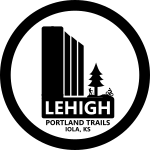There is a dazzling array of ecosystems at Lehigh Portland Trails, a remarkable variety for a relatively small property. There is a riparian zone along Elm Creek, a mature forest higher up on the ridges and on Mt. Lehigh, cedar-dominated forests, grassy woodlands, limestone glades, and an arid area along the bluffs with an almost southwestern feel.
In the southeastern portion of the Lehigh Portland Trails property is a very special area dominated by grass, which we call the “Lehigh Prairie”.
Tallgrass Prairie
At the time of settlement, Allen County was part of an immense sea of tallgrass prairie that stretched from Canada south through midcontinental North America. Tallgrass prairie consists of drought-tolerant grasses and forbs, along with occasional shrubs and trees. It is a lush landscape, with a huge number of different species, dominated by grasses, but alive with the vibrant colors of wildflowers. The openness and vitality of the prairie was maintained by periodic wildfires, which killed invading woody species while providing nutrients for fire-tolerant native plants.
As settlers moved in and domesticated the land, the natural patterns were interrupted. Fences partitioned properties, livestock grazed, soil was tilled for crops, and most of all, fire was suppressed. Even on the portions of the land that were not tilled or intensively grazed, without the periodic cleansing of fire, woody species eventually came to dominate. Today, the tallgrass prairie is but a small percentage of its historic domain.
The Lehigh Prairie
The area we call the Lehigh Prairie is about 10 acres, with open grassland in some places, along with a number of savanna-like sections. It ranges from dry scrubby grass to wet meadow, with an intermittent stream, a swath of lush boggy land that remains wet long after a rain, and numerous copses of trees.
There is some physical evidence of past land use. During roughly the first half of the 20th century, the land that is now the Lehigh Prairie was a farmstead. There was a house, a barn, a number of outbuildings, fences, and pens. The land was thoroughly domesticated.
At some point mid-century, the farmstead was purchased by the Lehigh Portland Cement Company, and slated for eventual quarrying of the underlying limestone and shale. The elements of the farmstead were demolished or allowed to deteriorate, and the land itself began to “go to seed” through neglect and inattention. When the cement plant and quarry were closed and then abandoned in the latter part of the century, the process accelerated. The land has sat vacant and unmanaged for nearly 50 years. The predominant underlying grass returned, but then nature began to reassert itself through invasions of weeds, shrubs, trees.
Today, grasses still predominate, but are under siege. Eastern Red Cedar, once constrained by fire, has overtaken vast swaths of land. Wetter areas now host Eastern Cottonwood and Elm, which grow fast and send out hundreds of thousands of seeds each season, a small percentage of which sprout, become seedlings, then saplings, then mature trees. There are portions of the grassland that the tree saplings are nearly too thick to walk through.
Along with the cedars and cottonwoods come other opportunistic species: elm, honey locust, osage orange. The grassland, now shaded by a canopy of leaves, thins out and eventually dies, leaving an understory of roughleaf dogwood, smooth sumac, aromatic sumac, poison ivy. Beneath the larger cedars, deprived of light, almost nothing grows.
Historic Photos
Looking back at historic aerial photos, we can begin to see how the land use and environment has evolved:




Prairie Restoration and Reconstruction
The vision is for Lehigh Prairie to be a richly vibrant prairie, dominated by native grasses, with seasonal color provided by native wildflowers. Small wildlife and birds will find a home. Pollinators such as bees and butterflies will be welcome. It will be a tranquil place, a place to take in nature’s beauty. A place very much alive.
This vision does not transpire through happenstance. Left unmanaged, the prairie will continue to deteriorate. Eventually, it will all turn to cedar, leaving only isolated pockets of grass or hardwood trees. It is likely, at some point, a wildfire will be sparked by lightning or a cigarette discarded by a passing motorist. Cedar, due to the oils contained in its needles, burns hot and fast. The entire place will go up in flames, leaving a smoking moonscape and the blackened skeletons of dead trees.
In order to prevent this sad outcome, the prairie needs to be restored. That means the removal of invasive trees, shrubs, and weed species, and the replacement of non-native grasses with native tallgrass prairie species. Restoral is, by and large, a manual operation — cutting trees, removing brush, creating open space for grasses to thrive, planting of native grasses and forbs. It will likely mean winter burning to eliminate dead grasses and damage weed seeds and any small woody invasives.
All of that will take time, labor, and funding. It is hoped that the process will begin in earnest within a few years. Watch for changes, and learn how you can help. Volunteers with prairie restoration experience are welcome! Please contact us if you can help.
